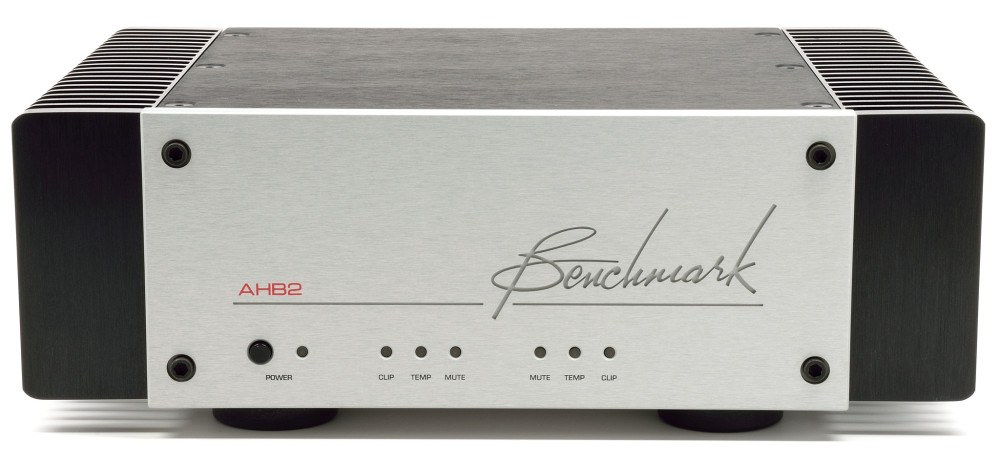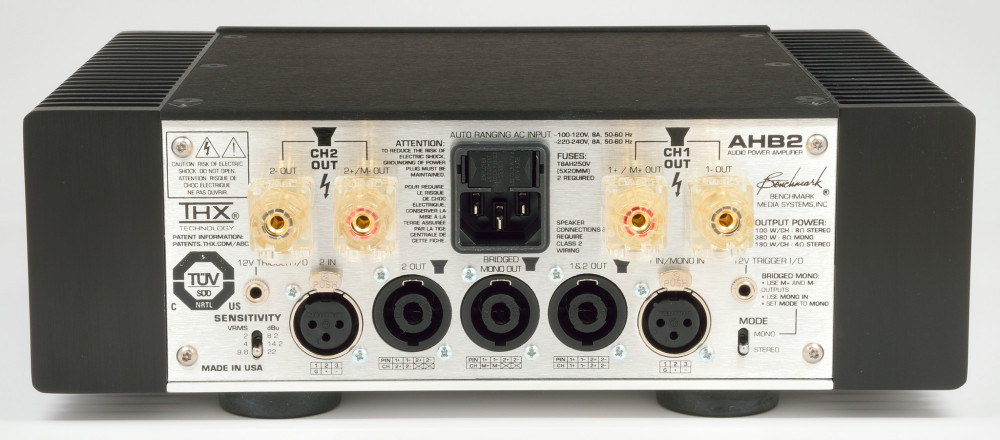Star Wars attack High End Audio
There’s a new actor in the high end audio amplification field – THX. The company is a technology spin-off from Lucasfilm, which originated the Star Wars movie series.
THX has patented a novel amplifier design, THX AAA TechnologyTM and Benchmark Media Systems has turned it into a new power amplifier – AHB2. The design is called Achromatic Audio Amplifier. Achromatic may mean colorless or neutral or without modulation. The AHB2 is an attack on current amplifier design. It’s basically an AB amp with a class H power rail arrangement. AB amplifiers are more efficient than Class A by utilizing a push-pull transition.
Class AB has two circuits to increase efficiency over A – straight amplification – and class B where ½ of the signal is used. Class H tracking rails deliver power on demand unlike linear power supplies that must have stand-by capacity.
The Dark Side in the amplifier war is distortion and heat. To win this battle the rebel alliance, i.e., THX and Benchmark, are trusting The Force (my name – not the official designation) in the shape of a low power Class A correction amplifier. The Force runs in parallel with the regular AB amplifier attack fleet and corrects mistakes and shores up any weakness caused by non-linearity in the transition stage. In addition, there’s a 3D amplifier that boosts the input signal in 3 selectable levels.
The Force also works on the H Class power rail system. Here again the battle is between efficiency and distortion. To provide high current on demand the H rails have to shift between stages which can ripple through as distortion. Benchmark’s clever design compensates for this with the Class A amplifier.
The AHB2 has a resonant zero-voltage switching power supply. The switching is carried out at frequencies well above the audio band to reduce any audible artifacts from the power supply. Switching power supplies are much more efficient, and smaller, than linear transformer based supplies but traditional designs (or wall-warts) are noisy and can affect power demand. The AHB2 power supply is regulated and very efficient in combination with the H Class rails. Benchmark claims that there is no sagging in internal voltage during high loads or when line voltage dips.
The AHB2 is a very compact and light weight amplifier. It’s exactly the size of a standard letter page – 8.5”x11” – and weighs 12.5 lbs. The output is rated as 100 W/channel into 8 Ohms, 190 W/channel into 4 Ohms and 380 W bridged Mono into 8 Ohms. Frequency response is a wide 0.1 Hz – 200 kHz +/- 3dB. Distortion – the key feature of the amplifier – is < -118 dB N+THD in Stereo Mode, while S/N is 132 dB A-weighted.
The AHB2 has balanced inputs only. Benchmark suggests adapters for single ended RCA cables. I tried my own XLR-RCA adapters but the result was less than excellent. The amp should really be fed a balanced signal for best performance – which is not a problem if your current equipment, including high-end cables, are balanced. Otherwise you may need to revise the upstream equipment.
I used Benchmark’s XLR cables which initially sounded questionable. After three days on my Cable Cooker they were actually quite nice – especially considering the price of $38 each or $76 per pair. The AHB2 responds well to cable upgrades but Benchmarks standard cables are a good starting point.
To recapitulate, the AHB2 is actually three amplifiers: a 3 stage input amp, an AB main amp and an amp to control and compensate for distortion.
The input amp has 3 levels of gain, 22 dBu, 14.2 dBu and 8.2 dBu for low, mid and high gain. The lowest gain is for studio equipment that have high input levels. Benchmark recommends using the lowest practical gain for optimum sound. I ran the AHB2 on the lowest gain which works well with the Benchmark DAC2 and also my Oppo BDP-105 which has volume output control. Most SACD and downloaded audio files had enough output voltage to play very loud. Switching to a higher gain is easy with the toggle switch on the back in case the recording is very quiet and needs higher volume is needed. On the opposite side there is a Bridge to Mono switch which can easily be mistaken for the gain switch. The unit puts out only one channel on both speakers in this case. Play “Girl from Ipanema” and if Gertrud is MIA you are running mono (guess how I know…).
The AHB2 can be bridged and operated as a monoblock. The power output goes from 100 W/channel to 380 W single channel. Biamping is also possible but will require NL4 4-pole cables. Benchmark’s can make cables with bananas or spades on the speaker end against a special order. However, the mono switch should also work.
Auditioning
So has The Force succeeded in beating the Amplifier Empire? Did The Force awaken new audio capability in old AB design? Can the AHB2 do the Kessel Run in under 12 parsecs?
I tried a number of configurations:
Digital
I evaluated high resolution digital files through my Oppo BDP-105 which plays SACD, DVD-A and Blu-Ray discs, and digital files from a USB stick. The Oppo has a volume control and XLR stereo outputs so it worked well with the AHB2. I also had access to Benchmark’s DAC2 HGC for DSD and other high res files from my Dell laptop.
Naturally, a test with The Dark Side (of the Moon) was needed. The opening heartbeats of Pink Floyd’s masterpiece (Capitol 2003 SACD) nearly bounced me out of my chair. Certainly no lack of low end extension on the AHB2. “Money” spilled coins out of my speakers. There was a wonderful crispness of the attack on the electric guitar. Dire Strait’s “Brothers in Arms” (Mercury Records 2005 SACD) thundered authoritatively with the AHB2. Drums on “Money for Nothing” were well placed on the sound stage and had excellent dynamics.
Conclusion: the AHB2 will easily handle rock music. Round one to the Rebel Alliance.
The AHB2 is a class AB amp – but could easily be mistake for a class D with its very compact dimensions. The small size is made possible by the compact switching power supply. A regular switching power supply can induce noise that is easily audible, so I had concerns that this would be the case with the AHB2.
The amplifier has a spectacular frequency response of 0.4 Hz to 200 kHz. This means that the AHB2 will amplify the high frequencies present on high res digital files (after conversion to analog, of course). SACD/DSD has noise near the audible limit of 20 kHz. Even if this can’t be heard directly, I find it affects the sound field and can be irritating. If an amp has a lower frequency response it can filter out some of this noise – but it will affect the sound by limiting wanted frequencies as well.
The torture test for high frequency extension and coherence in an audio system is female voices in choral or opera pieces. It may even torture the listener depending on musical taste – but I’ll gladly take one for the team. Actually, soprano voices can be quite wonderful if your system is properly tuned and you avoid CD recordings. (I have eight different red book recordings of Beethoven’s 9th to prove CDs are hopeless.)
The SACD Reges Terrae by Nordic Voices (Chandos Records 2007) is an a cappella recording of choral music from the sixteenth century performed by four sopranos and three male singers. It challenges any system with high frequency harmonies. It’s a good pick for the AHB2.
- (Page 1 of 2)
- Next page →


